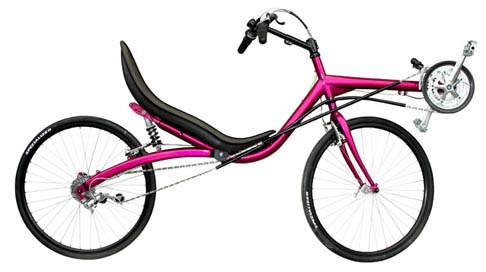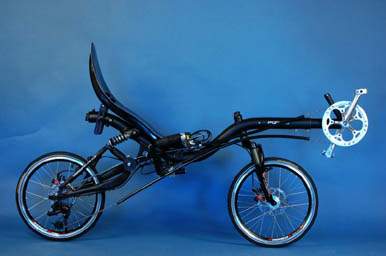
Recumbent Bikes
Written by Seven
A while ago, my girlfriend decided she needed a new bike. Her old one is a BMX-type bike she got from her dad, and the seat/handlebars position (even after adjusting) forces her to bend too much, which hurt her back and wrists. If you've to bike 20 km each day to work and back home, that's not fun at all. Each working day, we pass a bike shop specialized in recumbent bikes, and she was curious how easy riding such a bike would be. So after trying a few models at the shop, we rented one for a few days, which is quite necessary to get used to it. After testing it intensively, she decided to order one which we're now waiting for to be delivered. In the meantime, I'll make Adok happy by sharing our experiences, even though they don't have anything to do with the demoscene :)
So, what is a recumbent bike, for those who haven't seen such a thing? It's a bike where the driver lies reclined in a chair-like seat, with his feet and the pedals pointing forwards, instead of sitting upright as on a normal bike. This arrangement is much more aerodynamical, since your body presents a far smaller cross-section to headwinds. As a result of the lower wind resistance, you can drive faster with the same effort, or at the same speed with less effort. Recumbent bikes have existed for many years, and even hold many speed records for biking, until they were banned from international racing in 1934 for not being "proper" bikes. But since we just want to go from point A to point B, we don't care what a "proper" bike is :)
There exists a huge variety in recumbent bike models. The first large difference is in the position of the handlebars: they can be placed under the seat (which is called underseat steering) or above the frame, between the knees and the body (called overseat steering). Underseat steering is more relaxing, since your arms are besides your body, and you don't have to hold them higher as with over-seat steering. But with underseat steering, you can't turn as sharp because the handlebars hit the frame sooner, so your smallest turn circle is wider.

There are also different wheel sizes, from normal-bike wheels to children-bike sizes. This determines things like rolling resistance, seat height and center of gravity, but it's hard to make a general recommendation for one above the other. In the past, when frames were made from straight metal tubes because bending them made them weaker, many models had a large back wheel and a smaller front wheel, because this allowed smaller people from more easily put their feet back on the floor. With the current generation of frames, which are made pre-bent, this is no longer necessary and most recumbents have 2 big or 2 small wheels. This way, you only need to pack one kind of spare tube if you go on a long trip.
Another large difference is the seat position. Many people's first question about recumbents is: "But isn't it dangerous to sit so

low? The cars won't be able to see you!" This is true for the really low recumbents flat which are used for racing, with the seat maybe 15 cm above the ground, and the driver lying nearly horizontal. But for normal recumbents, the lowest point of the seat is usually 50-60 cm above the ground, and the seat is installed more diagonally. Granted, your head will still be half a meter lower than on a normal bike, but it's not nearly as suicidal as some people think :)
Regardless of the model, there are a few differences between recumbents and normal bikes that you should be aware of if you want to try one out. I did make a few short test rides myself, so part of this is personal experience, the rest I heard from my girlfriend.
- Starting: due to seating position, you can't push yourself to a rolling start as with a normal bike, and you can't go "stand" on the pedals either. This means you've to start just by pedaling, so you better start in a low gear, and remember to shift back to a low gear before coming to a full stop.
- Balancing: on a normal bike, you can balance by shifting the weight of your upper body left or right. On a recumbent, you lie with your back in the seat, so you can't shift your shoulders left or right. The only way to balance is by turning the steer, which takes some time getting used to. Expect the first few minutes on a recumbent to resemble "Bambi's first steps on ice" with plenty of fast turns and stopping to prevent falling. But after a while, you'll get used to it. Everyone who knows how to bike can learn to use a recumbent in an hour.
- Looking back: Again, since your upper body lies in the seat, you can't turn your shoulders when looking backwards. And since your neck can't turn much more than 90 degrees, checking out traffic behind you is more difficult. You can install small mirrors on you handlebars to fix this, or push your body in a more upright position before looking back.
- Bumps: As long as you drive on flat roads, recumbents are very comfortable. But when you drive up a sidewalk, in a small hole in the road or over any other bump, you can't stand up and bend your knees to absorb the shock. So you feel shocks more than on a usual bike, but since you're lying flat your backbone isn't compressed as hard. Driving over cobblestones for example will shake your whole body. Front-wheel suspension can help alleviate this a little (most recumbents have back suspension standard).
- Muscles: even though you still pedal as on a normal bike, the muscle groups you use differ slightly. You can expect the muscles on the inside of your thighs to ache a little until you're used to using them.
- Price: one big disadvantage to recumbents is the price: they cost easily between 1500 and 2000 euros, which is 2 to 3 times as much as a good-quality normal bike. One factor in this is economies of scale: since few people drive recumbents, it's more expensive to make the frames. A smaller one is quality of parts: it makes no sense to bolt the cheapest brakes, gears, wheels and chain on an expensive frame, since their total price is only a fraction of the price of the frame, but they're responsible for most of the problems and repairs. So those parts are also chosen to be of high quality, which also pushes the price upwards.
So, driving a recumbent bike takes some getting used to, and there are some disadvantages that you should keep in mind before paying big cash for one. But recumbents have their own advantages of course: the posture is more comfortable, especially if you have back, shoulder or wrist pain, and you can drive faster with less effort. During the few days my girlfriend could test one, I had to switch to a higher gear on my normal bike to keep up, and in strong headwinds I could hardly keep up with her. Also, people look curiously at you when you drive such a strange bike, which you may like or not depending on your personality :) So, if you've to bike long distances, and you're looking to replace your iron horse, it might be worth to rent a recumbent bike for a few days and see how it suits you.
Seven